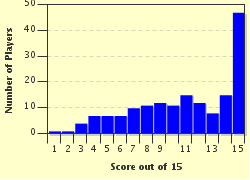Quiz Answer Key and Fun Facts
1. How many demons did Jesus cast out of Mary Magdalene, according to Mark 16:9 and Luke 8:2?
2. According to Matthew 27:55, what was the relationship between Jesus, and Mary Magdalene and the other women mentioned? (The Greek text uses the word 'diakonousai'.)
3. From where had Mary Magdalene and others followed Jesus (even to Jerusalem and Golgotha), according to Matthew 27:55?
4. In John 19:25, where does it say that Mary Magdalene was, when Jesus was on the Cross?
5. Matthew 27:61 reports how Joseph of Arimathea laid Jesus' body in the tomb, and (probably not alone) closed the tomb with the door-stone. Where, according to the verse, were Mary Magdalene and 'the other Mary' while this is done?
6. At what time of day, and on what day, did Mary Magdalene and the other women set out for the tomb to anoint Jesus' dead body?
7. As reported in Mark 16:3, what question was on the minds of Mary Magdalene and the others on their way to the tomb?
8. According to the angel, who or what was it that Mary Magdalene and the other women were seeking? (Matthew 28:5 and Mark 16:6)
9. In Matthew 28:6 (also Mark 16:6) what did the angel say to Mary Magdalene and the others about where Jesus was?
10. This angel also extended an invitation to Mary Magdalene and those with her. What did the angel invite them to do, according to Matthew 28:6 and Mark 16:6?
11. In closing, the angel instructed Mary Magdalene and her companions to go and tell the other disciples the news. However, in Mark's account, one disciple especially was mentioned in particular. Which one? (Mark 16:7)
12. According to Matthew 28:8, with what emotions did Mary Magdalene and the others return to the other disciples? (NKJV text used)
13. How, according to Matthew 28:8, did the women return to the other disciples with the news of Christ's resurrection?
14. Mark 16:8 records the women's amazed departure from the tomb, and how they fled in wonder. According to this verse, to whom did they tell their news? (NKJV text)
15. When Mary Magdalene encountered the risen Jesus in the cemetery garden, and recognised Him, what, most likely, was her response? (We might reasonably deduce it from what Jesus says to her in John 20:17).
Source: Author
Rimrunner
This quiz was reviewed by FunTrivia editor
CellarDoor before going online.
Any errors found in FunTrivia content are routinely corrected through our feedback system.


